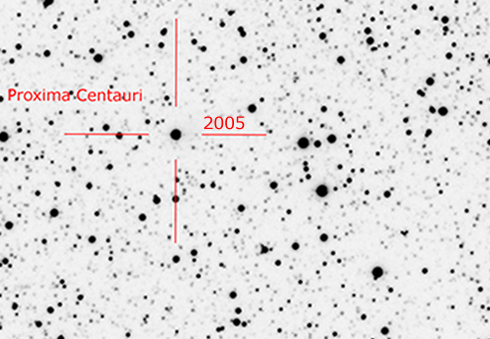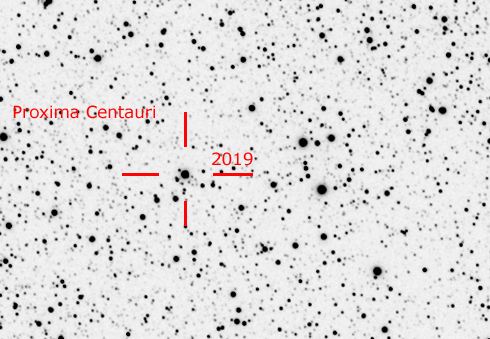 |
CHAMÄLEON + ONJALA OBSERVATORY DeepSky | SITEMAP HOME CHAMÄLEON |
|
 |
|||
| « back to overview Cluster | Load
higher resolution (1800 x 1200 Pixel 2800 x 2100 Pixel) |
Object description |

V 645 Cen - Proxima Centauri
This image is actually just to demonstrate how far away Proxima Centauri is apparently from the two main components Alpha Centauri A and B in the sky. The apparent distance between the main system and Proxima is more than 2 degrees.
Proxima Centauri (Latin proxima, the nearest), also called V645 Centauri or Alpha Centauri C, is the closest fixed star to the Sun, with a distance of 4.2445 +/- 0.011 light-years. Because it is inconspicuous with its low apparent brightness of the 11th magnitude class, it was discovered only in 1915. The proper motion is RA = 3.8"/year and DE = 0.8"/year.
Proxima Centauri is a red dwarf star with only 12.5% of the Sun's mass and a surface temperature of about 2,800 degrees. Its diameter is about 200,000 kilometers and it has about 130 times the mass of Jupiter. The designation V 645 indicates that Proxima is a variable star, of the class of flaring stars. The irregular brightness variations are about 10% of the normal brightness.
 |
For a
long time it was uncertain whether Proxima is really a physical triple star
system together with alpha and beta Centauri. Among other things with
astrometric measurements of the Hipparcos satellite the affiliation of Proxima
Centauri to Alpha Centauri was clarified at the end of 2016. Proxima orbits the
main system in a highly eccentric orbit with an orbital period of 591 000
years. Proxima is currently 0.2 light-years away from Alpha Centauri and is at
the farthest point in its orbit. In August 2016, the discovery of a planet - Proxima Centauri B - was announced. In 2017, ESO astronomers discovered a disk of cold dust around Proxima Centauri.. The image additionally shows several open star clusters and a 20 arcsec bipolar planetary nebula. « View annotated version with object designations |
| The main system Alpha A and Alpha Centauri
B Alpha Centauri (also known as Rigil Kentaurus or Toliman) consists of the brighter yellow star Alpha Centauri A and the orange-colored Alpha Centauri B. The apparent separation of both stars is currently just under 6 arcseconds and the distance to the Sun is 4.34 light-years. The orbital period of both stars around the common center of gravity is just under 80 years. The apparent separation is currently 6 arcseconds. » Older "Luck Imaging" image of alpha and beta Centauri taken by us at the primary focus of the Celestron 14. Unfortunately, further image information is no longer available. |
 |
Since 1998 we have been taking image sequences of Proxima Centauri from time to time to document the high proper motion of the flare star. The two images below show the position of Proxima in 2005 (left) and 2019 (right). Three different telescopes and four different cameras were used.
 |
 |
 |
The proper motion of Proxima Centauri
between 1998 and 2005 « The animation on the left shows the proper motion of Proxima Centauri to the distant background stars between the years 1998 and 2005 in three images The image data: (image orientation: east up, south left) 1998: 1998: SBIG ST8-X (pixel size 9 x 9 mü) and 10" RC at f = 1,700 mm. 31.05.1998 - 02:27 UT, exposure 300 seconds. Observation site: Tivoli 2002: SBIG ST10-XME (pixel size 6.8 x 6.8 m) and 5" Vixen ED refractor at f = 860 mm. 08.08.2002 - 19:45 UT, exposure 600 seconds. Observation site: Tivoli 2005: SBIG ST2000-XM (pixel size 7.4 x 7.4 mü) and 6" Zeiss APQ refractor at f = 1,200 mm. 08.08.2005 - 19:45 UT, exposure 600 seconds. Observation site: Rooisand. Click here to see a large image animation. |
 |
 |
 |
 |
 |
 |
 |
| Sun | Moon | Solar System | DeepSky | Widefield | Miscellaneous | Spec. Projects |